Sound not as memory but experience
 [Image: From Take a Closer Listen, designed and edited by Rutger Zuydervelt].
[Image: From Take a Closer Listen, designed and edited by Rutger Zuydervelt].Take a Closer Listen is a project by the talented Dutch graphic designer Rutger Zuydervelt in which a variety of people have been asked to describe their favorite sound. The results—which range from quick, five-word responses to entire short narratives about found sounds—were collected into an eponymous booklet, Take a Closer Listen, this past winter.
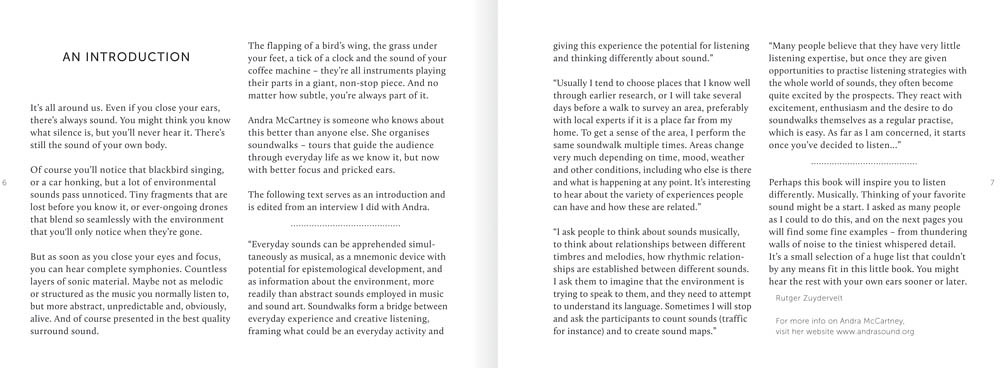 [Image: From Take a Closer Listen, designed and edited by Rutger Zuydervelt].
[Image: From Take a Closer Listen, designed and edited by Rutger Zuydervelt].Flipping through the pamphlet is like reading a silent soundtrack to a landscape you will never see in full.
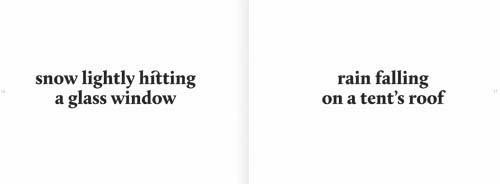
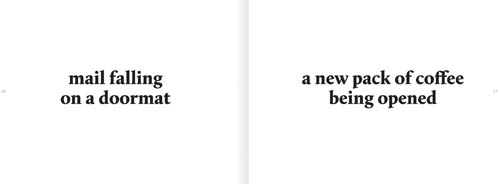 [Images: From Take a Closer Listen, designed and edited by Rutger Zuydervelt].
[Images: From Take a Closer Listen, designed and edited by Rutger Zuydervelt].Zuydervelt's original inspiration for the project is worth quoting in full:
- It was a beautiful, sunny day in July, and I was lying in a park in Geneva. My iPod was out of batteries, but I still had my headphones on. I closed my eyes and listened to the sounds surrounding me. Having these earphones in somehow gave me the idea that I was more actively listening than I normally would. As if these environmental sounds were playing on my iPod. A world was slowly unfolding to me. I could hear people talking, cycling, walking and roller-skating. A dog barking. A truck passing. Behind me, there was the rhythmic sputter of a sprinkler installation, and kids laughing and fooling around. I could hear a wine bottle being uncorked 3 and a box of crackers being opened. But most enjoyable were the sparrows, flying around nervously, trying to get hold of breadcrumbs. They were flying from tree to tree, from my left ear to my right. A chirp here and there. Sometimes they would burst out in an excited chirping laughter, as if they were watching a ballgame and someone scored. It felt like listening to a great radio play. I just had to do something with this. A project on environmental sound. Maybe a book?

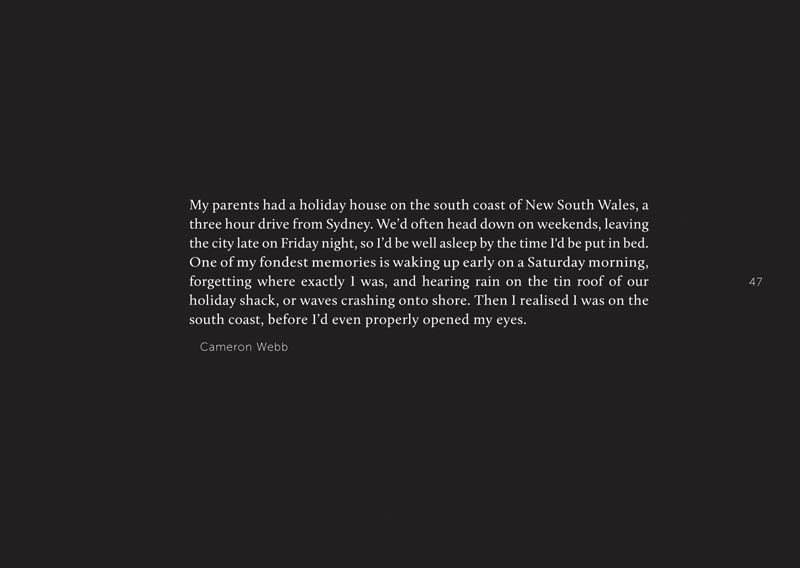
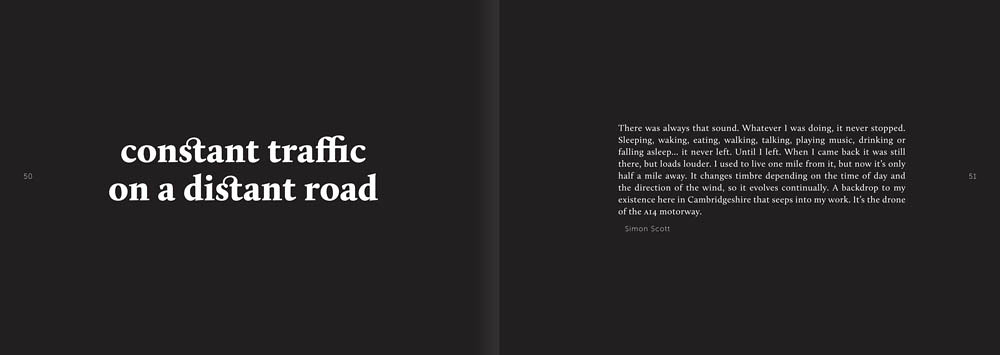 [Images: From Take a Closer Listen, designed and edited by Rutger Zuydervelt].
[Images: From Take a Closer Listen, designed and edited by Rutger Zuydervelt].Many of the stories are worth reading in full, if for no other reason than to watch how acoustic information is made narratively accessible through verbal description. Here is Romke Kleefstra, for instance, on "the flapping of birds' wings":
- In winter, over 30,000 geese spend the night at a roost near one of the Frisian lakes, not far from my house. At sunrise I often go there to watch them. Especially their spectacular departure. To fly to a nearby place to spend the day feeding on meadows, the geese will lift off together, in one big movement. Imagine a group of over a thousand percussionists, positioned in a diamond shape, all having a floor tom and two brushes. A split second after the rightmost percussionist starts a five second ruffle, the percussionists left of him do the same, and so forth. Further to the middle of the group, the sound grows louder, fading again when the middle is passed, leaving the leftmost percussionist to make the final beat on his kit. A group of alto sax players is mimicking this movement by simultaneously blowing short puffs. It’s truly incredible.
- A few years ago, I wandered into a tube station on the deeply buried Central Line in London. Along the platform and out of my line of sight, three or four girls were singing close RnB harmonies. By the time this arrived at my ear, it had been bounced along several hundred metres of tunnel, an unfathomable series of natural comb filters that rendered it an unintelligible but gorgeous wooze, speckled with the faint percussive clank and rumble of a fully operational mass transit system.
Although I sometimes record environmental sounds, you can never really be prepared for those one-off events that take you by surprise. In a way, I’m glad all I was able to do was stand and listen when I chanced upon the most beautiful improvised arrangement. I think every piece of music I have ever made has tried but fallen short of recalling this moment.
In other words, are sounds really the disappearing remnants of a world that we are always trying—and failing—to reassemble? Is there really always a connection between sound and memory or sound and nostalgia—not sound and physical experience, say, or even sound as a subset of astronomy?

 [Images: From Take a Closer Listen, designed and edited by Rutger Zuydervelt].
[Images: From Take a Closer Listen, designed and edited by Rutger Zuydervelt].For instance, as a rhetorical counterexample—one that does not rely on memory at all in order to communicate the acoustic and experiential value of a given sound—here is Nate Wooley on "the drone of an electrical generator":
- There’s a giant generator that heats and cools the large library building for the main campus of New York University. The sound of its drone is very deep, rich and colorful. The overtones seem to dance above a base set of fundamentals the same way as in an Eliane Radigue or Phill Niblock piece. It changes slowly and organically, almost imperceptibly, from one place to the other. No one just walking by would ever even notice its almost human quality, but if you stand and listen for five minutes, the building seems to breathe and sing.
- I love the sound of paint tins in an outside building responding to shifts in temperature. When they get warm, the air inside the tins expands, and then when they cool down again, the air contracts, pulling the metal lids down with a subtle, percussive clunk. I love how it sounds a little bit like a steel drum—sort of musical and metallic. And I love how the sound always comes as a surprise.
 [Image: From Take a Closer Listen, designed and edited by Rutger Zuydervelt].
[Image: From Take a Closer Listen, designed and edited by Rutger Zuydervelt].Of course, certain sounds do seem maddeningly unrepeatable and lost to time—for instance, the utter weirdness of things like the Bloop, Julia, and the eery Slowdown, even, for that matter, #pdxboom—but I have to wonder if the gossamer-like ghostly nature of sound, its always-slipping-away-into-nothing-ness, is not simply the result of writers emotionally acting out their own inability to conjure a sound in its precise and every detail. The language used becomes a performance of personal yearning, not a description of the sound at all.
But descriptions are descriptions, not technical reproductions of noise itself. I'm reminded of those ads from seven or eight years ago—perhaps produced by Meineke?—in which customers were shown unsuccessfully acting out the strange noises their car engines had begun to make, implying that fixing an automobile is at least as much about re-tuning industrial machinery to fit within an appropriate acoustic range as it is about remedying potentially fatal mechanical flaws. It also makes me wonder if a car has ever been recalled because it sounded bad. (See also my recent Q&A with sonic historian Sabine von Fischer for the Canadian Centre for Architecture about some of these ideas: Noise versus noise).
In any case, Take a Closer Listen is a fascinating project, and I would love to see it opened up to the entire commenting public, perhaps as a dedicated website, a global archive of acoustic descriptions from anyone who wants to log-in.





Comments are moderated.
If it's not spam, it will appear here shortly!
great little project. when working with sound one of the greatest challenges is to share the experience with language. sonic language often fails to be as expressive as visual language. I know a number of artists and researchers who are trying to explore this issue more thoroughly.
When I woke at 4:57am today in rural Vermont, I realized I had been woken up by birdsong. The air was so packed with it you couldn't distinguish one call from the next. And it was loud, startlingly so. My 2-year-old woke up asking for milk and a spot in my bed. Neither of us fell back asleep.
Then I thought about waking up in NYC when I lived there a few years back and what that sounded like--traffic, traffic, traffic--tinny, grinding, a cacophonous din, sometimes a hum that could sound like surf if you forgot where you were (which was never easy).
On first read, I didn't see any connection to my work (in Communications at the Orton Family Foundation where we assist small cities and towns plan for their most vibrant and sustainable futures). But then I thought, wait, of course sound corresponds with place and our experience of it...and maybe even why it ends up mattering to us.
So the question for me and my colleagues is this: Can we effectively engage residents in communities across the country by talking about the sounds of their towns and what it would be like to live there if those sounds disappeared or were replaced by something else entirely?
They might laugh us right down Main Street, but we've been laughed down Main Street before (we use storytelling as one of our primary engagement approaches in municipalities under 50,000). After the initial skepticism, they start listening to themselves and each other a little differently than they did before. Suddenly, they're reminded of the importance of the working farms (tractor engines, bailers) and local schools (laughing kids) and gathering places (church bells, music, espresso machine, poetry, a pool cue on an 8 ball) and parks (barking dogs, more kids playing, footsteps, the whir of bicycle wheels).
Plan to write a post on our blog about this, and will add the link here when I do.
Great stuff. Thanks.
Here's the link to the blog post I wrote in response to this post:
Enjoy, and thanks for the inspiration.
Best,
Jill
Post a Comment